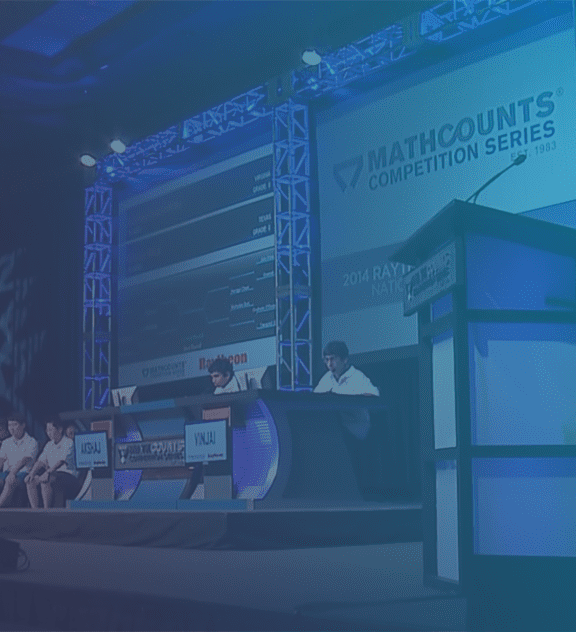
AN INTERVIEW WITH TAREN LONG
MATHCOUNTS Monthly, February 2022
Taren Long, a longtime coach at Chesapeake Public Charter School in Lexington Park, MD, served as the 2020-2021 DoD STEM Ambassador for MATHCOUNTS with a focus on the Competition Series. In this role, Taren created several MATHCOUNTS Practice Plans and conducted outreach for MATHCOUNTS programs.
We interviewed Taren about how she recruits a diverse group of kids for MATHCOUNTS programs and how she uses MATHCOUNTS resources. Read the full interview below!

On recruiting more students to participate in MATHCOUNTS…
What advice or strategies would you suggest for teachers trying to bring in more students to their MATHCOUNTS programs, including students who may be leery about joining because of how they feel about math?
I would suggest looking through some of the MATHCOUNTS tasks and incorporating them into instructional time to expose all students to the types of problems that MATHCOUNTS provides. I recently ran an “elective” that was a combination of the MATHCOUNTS math club and MATHCOUNTS competition, and few signed up. When I did one of the MATHCOUNTS games with my actual math class, though, a bunch of students expressed that they would have signed up for the elective if they had really known what it was about. Many students see even the word “math” and get anxious, so starting with some activities/games and building in time for all students to play and reflect is a great way to introduce them to the MATHCOUNTS programs without telling them they are doing extra math.
I think another important thing to consider is when you are offering the club. For example, can you have students try one of the MATHCOUNTS games, such as The Multiplication Game, during a Station activity during your class time? Can you offer club meetings during lunch once or twice a week? Does your school have electives where you can encourage students to sign up for the club? I did all of these things over the last few years. Even when we were fully virtual due to COVID, students met with me on Fridays at lunch virtually and we ate lunch together while trying out problems using a shared Google Slides file.
On encouraging and welcoming diverse students…
We know some of our coaches and club leaders struggle to recruit students of color or girls to their program. As someone who teaches diverse students and has cultivated a representative MATHCOUNTS program, what do you find has worked best for you in encouraging students who are from groups underrepresented in STEM to join and making all feel welcomed?
In my math classroom, I feature a Mathematician/Scientist/Engineer every Monday as our warm-up, focusing on people from underrepresented populations. We read a short bio and discuss/come up with questions we have about that person and their life/academic contributions. I make a large effort to make sure students see themselves and people who look like them as successful mathematicians.
There have been times I have made concentrated efforts to get [individual students] to join as well. For example, I encouraged one student to work with me at lunch on a day I was also hosting a lunch-time math club meeting and aligned the activity for the day with something I knew the student already had confidence with. They were less intimidated and were comfortable participating a bit without feeling like they were being forced to join.
On resources that are especially helpful…
What MATHCOUNTS resources do you use most? Which resources have you found to be most helpful in preparing your students to compete and building their problem-solving skills?
I really enjoy the Problem of the Week layout. The students enjoy how there is one scenario that is being built upon, and they don’t have to rush to an answer. Instead, we focus a lot on how to manage the problem-solving techniques they would like to use. I also like the warm-up and workout exercises. Often, I will ask students to try those problems independently and then share their strategies. We will use those strategies to guide discussions about math content and techniques. I also like that instead of jumping from topic to topic, we can build out one and I can preview it to be sure it is something approachable for my students given what we have covered in class.
On advice for new coaches...
You’ve been a MATHCOUNTS coach for about a decade. What do you know now about coaching that you wish you had known in your first few years?
I wish I had known how valuable the materials from MATHCOUNTS were in my daily instruction. My first few years, I tended to think of MATHCOUNTS and my classroom math instruction as two disjoint sets. Instead, there are plenty of natural instances where the two overlap and can provide more opportunities for my students to tackle tough problems in a variety of ways.
On creating Practice Plans for MATHCOUNTS...
You created some new MATHCOUNTS Practice Plans as part of your work as a DoD STEM Ambassador last year. What made you choose the topics you did, and what did you enjoy most about creating these plans?
I chose the topics that I would use with my own students, and covered something that I didn’t think was already addressed in depth in a Practice Plan already. I actually piloted a few of the problems from the Practice Plans with my math students last year while building them to see how they flowed from one task to the next, and so I could see how they would approach the problems before receiving instruction. I enjoyed looking through MATHCOUNTS problems from previous years to find ones that aligned with the topics I had chosen. I remember printing out a large document with twenty or so problems that ‘looked’ like they would fit, and then solving them and writing out my steps to put the problems in a logical order for my Practice Plan–and realizing which ones didn’t really fit into my scenario. I also remember losing my note-sheet numerous times and having to re-solve them! Honestly, it was really fun to just sit around and puzzle out challenging math problems and find strategies that would be approachable for middle school students.




